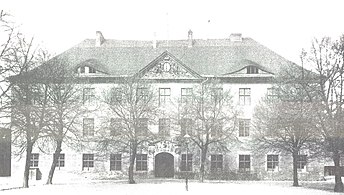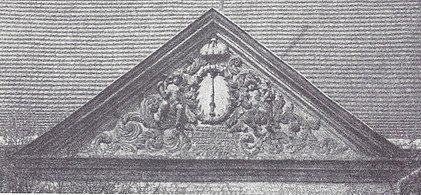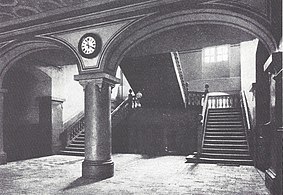Brandenburg University of Frankfurt
The Brandenburg University of Frankfurt , also called Alma Mater Viadrina or Viadrina for short , was the first university in Brandenburg . It was founded in Frankfurt (Oder) in 1506 . In 1811 it was closed and merged with the University of Breslau .
history
founding
1498 put Pope Alexander VI. a letter of foundation for the university. In the same year, construction of the college building began on the site of a synagogue destroyed in a pogrom . The construction manager was Stephan Hundertmarks, who later became mayor. The financier was the city council . By the time the two-story building was completed in 1507, the project cost the city 1,100 shock groschen .
On March 15, 1506, Pope Julius II approved the establishment of the Alma Mater Viadrina. It was founded on April 26, 1506 by Elector Joachim I as the first university in Brandenburg . In the year it was founded, over 900 students from Germany, Poland, Sweden, Norway and Denmark registered. The city of Frankfurt an der Oder then had 5,000 inhabitants .
The four classic faculties were operated at the Viadrina, i.e. theology , law , medicine and philosophy .
Name Viadrina
The name Viadrina comes from Latin and can be translated as "the one on the Oder ". The origin of the name Viadrus as the name of the Oder is controversial. It is assumed that the neo-Latin name Viadrus was introduced for the Oder by the Frankfurt professor Jodocus Willich . It can be found in the Frankfurt cityscape of Cosmographia from 1550. The wood engraving from 1543 is the first cityscape of Frankfurt; the map for Germania magna in the Ulmer Ptolemy edition of 1482 mentions the name Viadus fl.
development
To the pride of the city, the Kollegienhaus received a water pipe in 1511. Twelve salaried masters from the artist faculty taught in the two lecture halls .
Shortly after 1516, the library with the first holdings from an inheritance from the late Siegfried Uttensberger was laid out in the attic. From 1659 Jonathan Le Clercq was the university's first librarian . Alongside the state and university library in Königsberg, the library became one of the largest in Prussia .
In the plague years of 1613, 1625, 1626 and 1656, the university was relocated to the nearby town of Fürstenwalde / Spree .
In 1678, on the orders of Elector Friedrich Wilhelm, a botanical garden was laid out west of the building . Bernhard Friedrich Albinus had an anatomical theater built on the ground floor in 1684 .
The building was threatened with collapse in 1690 due to damage from the Thirty Years' War and the subsequent neglect of the building fabric. From 1693 to 1694 the building was then thoroughly restored and raised by one floor, the decorative gables were removed. Above the entrance was a crescent Madonna . The cartridge bore the inscription:
closure
The renewal of Prussia after the Peace of Tilsit (1807) also included a reform of the universities. When the (Pietist) Friedrichs University Halle was closed by Napoleon Bonaparte after the battle of Jena and Auerstedt , it was replaced in 1809 by the (reformed) Friedrich Wilhelms University in Berlin . The Crown of Prussia closed the Viadrina in August 1811 and united it with the Leopoldina in Breslau to form the Silesian Friedrich Wilhelms University . Many professors went to this new full university , others to Berlin. The library's holdings of around 28,000 books were shipped across the Oder to Wroclaw in the same month at the instigation of Professor Schneider .
Further use of the Kollegienhaus
After the university closed, the middle floor was given to the pastry chef Couriol, who was allowed to host masked balls there. In 1815 the building passed from the state to the ownership of the city and the basement floors were used as hay and straw stores. In return, the city left the city school building, the city courtyard, to the state. However, the library of the Royal Friedrich School has been located on the top floor since 1758 .
In 1822 the building was converted into a city school after the stocks had been moved to the nearby Fouragemagazin . The renovation was planned by the town planner Clemens; The work was carried out by master bricklayer Riegel. School operations began in November 1824.
On April 25, 1911, the school moved to a building on Wieckestrasse. From 1914 to 1945 the Kollegienhaus served as a primary school (Georgenschule). It survived the Second World War without major damage and was therefore used in 1945 as accommodation for refugees from the eastern regions of the German Reich .
After that, the building remained unused. In 1953 there were plans and funds had already been granted to set up a youth club here; however, the plans were rejected by the State Planning Commission . Efforts to protect monuments were also unsuccessful. On December 20, 1962 at 2 p.m., the building, which had since fallen into ruin, was demolished to make way for a planned residential complex.
- Photographs, ca.1911
Rectors
Between 1506 and 1811 there were more than 250 different prorectors . Rector was the sovereign . Many professors were rectors several times. From 1509 to 1749, the filling of the position changed every semester.

- Konrad Koch (Wimpina) (1460–1531), founding rector. He put up 106 counter- theses to Martin Luther's 95 theses , the author of which was Johann Tetzel . On the basis of the counter-theses, Tetzel held a disputation on the sale of indulgences on January 20, 1518 at the Viadrina .
- Ambrosius Lacher (around 1470–1540)
- Johann Blankenfeld (1471–1527)
- Gregor Günther († 1519)
- Ludolph Schrader (1531–1589)
- Johann Knobloch (1520–1599)
- Erdmann Copernicus († 1573)
- Heinrich Wenzel von Münsterberg (1592–1639) WS 1608
- Conrad Bergius (1592-1642) 1629
- Johann Brunnemann (1608–1672) WS 1638, 1649, 1655, 1669
- Johann Christoph Bekmann (1641-1717) 1672
- Arnold Wesenfeld (1664–1727)
- Johann Lorenz Fleischer (1689–1749) SS 1745
- Johann Samuel Friedrich von Böhmer (1704–1772) 1759, 1769
- Christian Ernst Wünsch (1744–1828) 1792, 1803 a. 1811, last rector
students
Before she was moved to Wroclaw , 55,000 people were studying at the Alma Mater Viadrina.

Well-known students (selection)
- Hermann Trebelius , poet and printer (around 1475 – after 1515)
- Ulrich von Hutten (1488–1523), humanist
- Erhard von Queis (around 1490–1529), Bishop of Pomesania, pioneer of the Reformation in Prussia
- Thomas Müntzer (around 1490–1525), theologian and leader in the peasant war
- Jodocus Willich (1501–1552), polymath and professor in Frankfurt
- Gregor Lange (1540–1587), composer, cantor at St. Mary's Church
- Michael Praetorius (1571–1621), composer
- Jakob Schickfuß (1574–1637), chronicler of Silesia, university notary and imperial council and chamber tax office
- Johannes Fleischer the Younger (1582–1608), one of the first Germans in North America, first doctor and academically trained botanist in English North America
- Martin Willich (pastor) (1583–1633) Lutheran theologian;
- Tobias Magirus (1586–1652), polyhistor and professor in Frankfurt
- Martin Opitz (1597–1639), poet, diplomat and scholar
- Martin Friedrich Seidel (1621–1693), historian
- Samuel Stryk (1640–1710), professor and three times rector in Frankfurt
- Johann Christoph Bekmann (1641–1717), polymath and professor in Frankfurt
- Christian Thomasius (1655–1728),
- Jakob Heinrich Graf von Flemming (1667–1728), Electoral Saxon Minister and Field Marshal
- Andreas Ottomar Goelicke (1671–1744), physician
- Carl Philipp Emanuel Bach (1714–1788), composer
- Ludwig von Pfuel (1718–1789), major general
- Johann Gottlieb Walter (1734–1818), anatomist
- Friedrich Gedike (1754–1803), educator
- Carl August Wilhelm Berends (1759–1826), physician, professor in Frankfurt
- Konrad Engelbert Oelsner (1764–1828), political publicist
- Wilhelm von Humboldt (1767–1835), scholar and statesman
- Alexander von Humboldt (1769–1859), natural scientist
- Heinrich Zschokke (1771–1848), publicist, educator, private lecturer in Frankfurt
- Heinrich von Kleist (1777–1811), playwright
- Ludwig Berger (1777–1839) composer, pianist
- Johann David Erdmann Preuss (1785–1868), historian
- Alexander von der Marwitz (1787–1814), Brandenburg nobleman and pen pal of Rahel Varnhagen von Ense
Jewish students
When the university opened, as in most of Europe, Jews were prohibited from enrolling. When Elector Johann Sigismund (Brandenburg) converted to the Reformed Church in 1613, the Frankfurt University tended more and more to Calvinism . The later professor, university librarian and rector Johann Christoph Bekmann visited the University of Leiden , which was open to Jewish students, as part of an educational trip in 1663/64 and was “taught in Talmudic and Arabic” by Rabbi Jacob Abendana in Amsterdam . In 1673, Bekmann opened a printing house in Frankfurt that printed Hebrew works, including the first complete edition of the Babylonian Talmud in Germany in 1697 .
On April 29, 1678, the elector Friedrich Wilhelm Gabriel Moschowitz (also "Gabriel ben Mose") and Tobias Moschowitz (also "Tobias ben Mose" from Metz) granted the right to study at the university as the first Jewish students. Studying, however, was not easy due to the professors' insults and derogatory remarks about Judaism. Both later obtained their doctorate at the University of Padua , as they were denied it in Frankfurt. Tobias later became the Sultan's personal physician in Constantinople . Salomon Liebmann was the next recorded Jew, who also studied at the Viadrina from 1695 at the behest of the elector. A Jew received his first doctorate on October 15, 1721. Moses Salomon Gumpertz , who had previously studied at Charles University , received his doctorate . By 1794, 29 Jews had received doctorates in medicine, including Marcus Elieser Bloch .
The last registered Jewish student at the old university was Wilh. Salomon Hirschel, who signed up on September 28, 1810; However, he could not finish his studies due to the closure of the university in Frankfurt. A total of about 140 Jews had studied in Frankfurt by then; most of them came from Poland-Lithuania , some from Prague and Amsterdam, one from London.
Wreath
The students were organized in small circles . The conscripts wore country team uniforms. On February 16, 1798, the Frankfurter Kränzchen founded the first senior citizens' convention in Germany. The SC-Comment is the oldest preserved.
Aftermath
In 1906, the city of Frankfurt held a 400th anniversary celebration to commemorate the founding of the university. “Our city will hardly ever be the seat of a university again,” one lamented.
180 years after the university closed in July 1991, the European University Viadrina was re-established in Frankfurt .
Today the street name An der Alten Universität and a relief wall remind of the former university.
literature
- Ewald Horn : Comments on the statutes of the philosophical faculty in Frankfurt a. O. Pedagogical Archive, Monthly for Education, Teaching and Science, Vol. 42 (1900), pp. 587-592.
- Erich Röhlke: Anciency and continuity in the register of the Viadrina in Frankfurt a./O. Once and Now, Yearbook of the Association for Corporate Student History Research, Vol. 18 (1973), pp. 142–154.
- Günther Hasse, Joachim Winkler (ed.): The Oder University Frankfurt. Contributions to their history. Böhlau, Weimar 1983.
- Annual reports of the Association for Research into the History of the Viadrina, Volume 1 (1998) - Volume 5 (2005/06). scrîpvaz-Verlag, Schöneiche near Berlin. ISSN 1437-1715
- Michael Höhle: University and Reformation. The University of Frankfurt (Oder) from 1506 to 1550. Böhlau, Cologne 2002.
- Irina Modrow: According to what “anyone who just wanted to, could do good studies in Frankfurt ...” A brief history of the Viadrina. scrîpvaz, Schöneiche near Berlin 2006.
- Ralf-Rüdiger Targiel : From the Great College House at Frankfurt University. The Mark Brandenburg. Journal for the State of Brandenburg, Issue 63, Marika Großer Verlag, Berlin 2006, ISBN 978-3-910134-22-5 .
- André König: Alma mater Viadrina. The Mark Brandenburg. Journal for the State of Brandenburg, Issue 63, Marika Großer Verlag, Berlin 2006.
Web links
Individual evidence
- ↑ certificate of 9 July 1518 inscription SIGILLUM RECTORIS štúdií FRANGFURDII
- ↑ Joachim Schneider: About the origin and variants of the river name Oder. In: Messages of the historical association to Frankfurt (Oder). 2003, issue 1, p. 14.
- ↑ Map on "Germania magna" according to Ptolemy, 15th century.
- ↑ Ernst Otto Denk u. a .: VIADRUS. Home register for Bad Freienwalde, Bad Freienwalde Touristik GmbH, 2009.
- ↑ German: “I want to raise my banner for the people; then they will bring your sons in their arms. Isaiah 49:22. "
- ↑ Anja Persinger in: Märkische Oderzeitung / Frankfurter Stadtbote. April 15, 2006, p. 15.
- ↑ Register of the University 1506–1811 ( archive.org ).
- ↑ Johann Tetzel's counter theses luther2017.de, January 24, 2017.
- ^ B. Brilling: Founding and privileges of the Hebrew book printing company in Frankfurt aO Breslau 1936, p. 267. Here after Ralf-Rüdiger Targiel, Mitteilungen Frankfurt Oder , 1999, p. 10.
- ↑ Bekmann's work Historia Orbis Terrarum, Geographica et Civilis uni-mannheim.de, see introduction.
- ^ Ralf-Rüdiger Targiel: With the permission of the elector, matriculated in Frankfurt - Jewish students at the Viadrina. Communications Frankfurt (Oder). Historical Association of Frankfurt (Oder) e. V. (Ed.), 1999 Issue 1, pp. 10-16.
- ↑ Erich Röhlke: About the Kränzianertum at the Viadrina [Frankfurt ad O. 1763 / 86-1811]. Einst und Jetzt, Vol. 17 (1972), pp. 113-125.
- ↑ Erich Bauer (Ed.): 14 of the oldest SC comments before 1820. Einst und Jetzt, special issue 1967, pp. 5–8.
- ↑ The secular celebrations of the Alma Mater Viadrina (1606–1906) (PDF; 646 kB) Andrea Lehmann, 2005
- ↑ From the first decade of the university and the oldest dean's books by lawyers and medical professionals. Festschrift for the four hundredth anniversary of the Alma Mater Viadrina / ed. by Gustav Bauch. M. & H. Marcus, Breslau 1906
- ^ Acts and documents from the University of Frankfurt Ao Verlag by M. & H. Marcus, Breslau 1907.
Coordinates: 52 ° 20 '56.4 " N , 14 ° 32' 55.9" E








